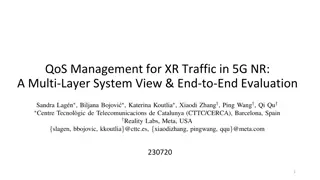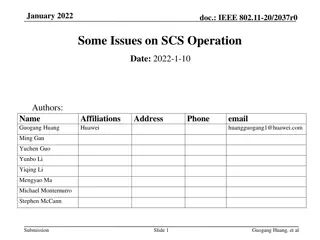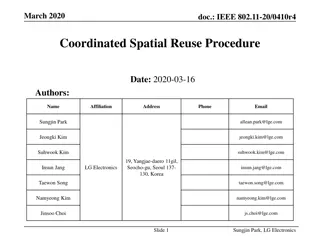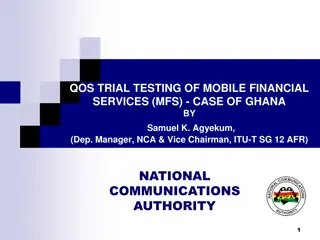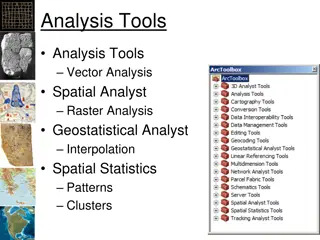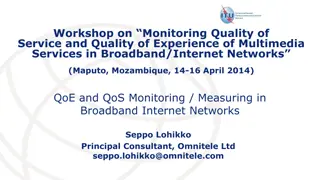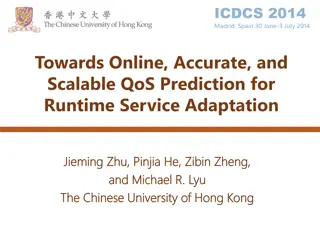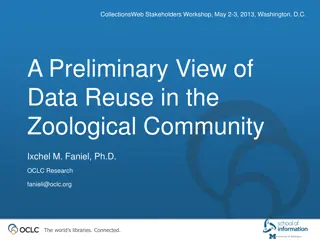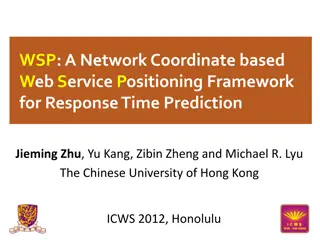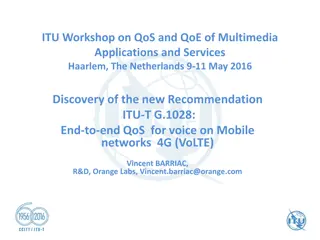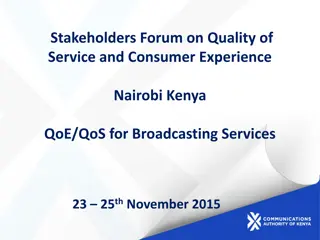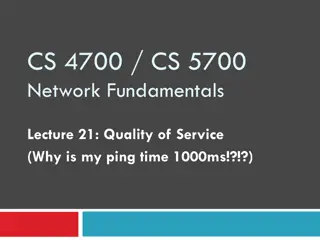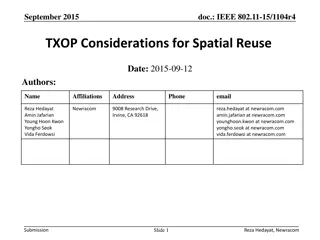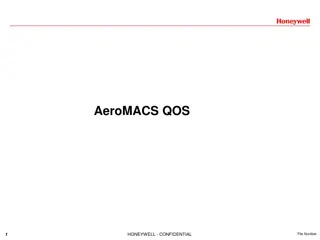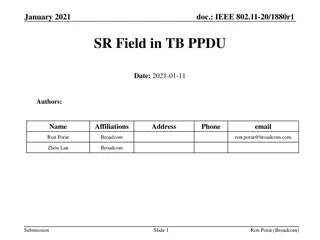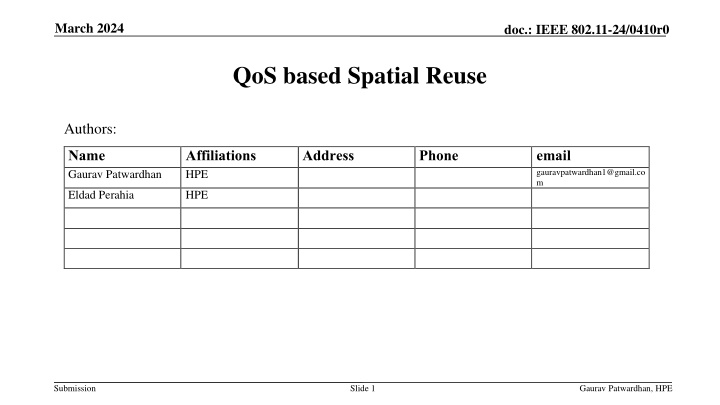
Enhancing Channel Access for QoS-sensitive Flows in Wireless Networks
Simulations based on real enterprise deployments demonstrate the impact of Spatial Reuse on throughput for multiple Access Points and devices. By adjusting OBSS PD thresholds, significant improvement in channel access for QoS-sensitive data flows can be achieved, enabling the utilization of wider channel bandwidth effectively.
Download Presentation

Please find below an Image/Link to download the presentation.
The content on the website is provided AS IS for your information and personal use only. It may not be sold, licensed, or shared on other websites without obtaining consent from the author. If you encounter any issues during the download, it is possible that the publisher has removed the file from their server.
You are allowed to download the files provided on this website for personal or commercial use, subject to the condition that they are used lawfully. All files are the property of their respective owners.
The content on the website is provided AS IS for your information and personal use only. It may not be sold, licensed, or shared on other websites without obtaining consent from the author.
E N D
Presentation Transcript
March 2024 doc.: IEEE 802.11-24/0410r0 QoS based Spatial Reuse Authors: Name Gaurav Patwardhan Affiliations HPE Address Phone email gauravpatwardhan1@gmail.co m Eldad Perahia HPE Submission Slide 1 Gaurav Patwardhan, HPE
March 2024 doc.: IEEE 802.11-24/0410r0 Abstract Simulations using pathloss and SNR measurements from real enterprise deployments demonstrate that Spatial Reuse degrades throughput for many of the APs and non-AP STAs in the deployments However, modifying SR to allow for access category specific OBSS PD thresholds dramatically improves channel access for QoS sensitive flows, enabling use of wider channel bandwidth Submission Slide 2 Gaurav Patwardhan, HPE
March 2024 doc.: IEEE 802.11-24/0410r0 Simulating Capacity based on REAL Enterprise Deployments step 1 A professional tool is used to generate a channel number and EIRP for all the APs in a real Enterprise deployment based on desired bandwidth. We collect AP-to-AP pathloss measurements between all these APs and also collect client SNR measurements in this deployment. Pathloss between APs is used to calculate interference OBSS links in the simulation. Client SNR data is used for intra-BSS links in the simulation. No 802.11 pathloss modeling is used, as we have found in the past that 802.11 pathloss models to not accurately model many enterprise deployments. Submission Slide 3 Gaurav Patwardhan, HPE
March 2024 doc.: IEEE 802.11-24/0410r0 Simulating Capacity based on REAL Enterprise Deployments step 2 PHY Layer link simulation was developed to estimate system capacity assuming a certain traffic load/utilization CCA is modelled for channel access. If OBSS signal is above the CCA PD level when a STA is attempting to transmit, channel access is blocked for the STA Data rate is computed based on SINR. If the SINR is below that required for MCS 0, the link fails. Traffic load is modeled by a random probability that a STA attempts to transmit. Physical Layer throughput is computed at each AP in terms of a distribution across all clients in the BSS. PHY Layer throughput is multiplied by 0.5 to approximate 50% IP and Medium Access Control layer efficiency (i.e. TCP/IP and 802.11 MAC). This is called Goodput We then look at the median goodput and worst 5%-ile goodput for each AP, for a particular offered traffic load This models the average client performance in a BSS and a bad/edge client performance in a BSS We collect statistics on blocked links and failed links, which provide an abstraction for latency/jitter The simulation has been verified against real deployments, and has proven to accurately model throughput. Submission Slide 4 Gaurav Patwardhan, HPE
March 2024 doc.: IEEE 802.11-24/0410r0 Simulating Capacity based on REAL Enterprise Deployments step 3 To investigate Spatial Reuse, we run the simulation with different OBSS PD levels. Default CCA PD Threshold is -92 dBm (estimate of typical signal detection level). We compare goodput for each AP when changing OBSS PD level from -92 dBm to other levels Submission Slide 5 Gaurav Patwardhan, HPE
March 2024 doc.: IEEE 802.11-24/0410r0 Corporate Office Building The first data set was collected from a corporate office building. The deployment consists of four floors with over 150 APs We run the simulation for 20, 40, and 80 MHz channel bandwidths. We model a busier period with traffic load of 50% Each dot in the graph represents the throughput of a BSS Simulations indicate that 80 MHz channel bandwidth results in highest median and 5% BSS throughput That said, corporate IT chose 40 MHz. Submission Slide 6 Gaurav Patwardhan, HPE
March 2024 doc.: IEEE 802.11-24/0410r0 Quality of Service In addition to throughput, we collect blocked link and failed link statistics to model latency/jitter As expected, with increased channel bandwidth and increased frequency reuse, the probability of links being blocked or failing due to interference increases Corporate IT chose 40 MHz as a balance between throughput and quality of service Submission Slide 7 Gaurav Patwardhan, HPE
March 2024 doc.: IEEE 802.11-24/0410r0 Spatial Reuse Can we increase throughput/system capacity with SR? We rerun the simulation with OBSS PD level increased to -82, -72, -62 dBm. From the bottom left plot, the CDF lines cross each other and it is difficult to tell if there is improvement with SR. Alternatively, for each BSS we calculate the difference in throughput between the SR OBSS PD level and the baseline of -92 dBm. This is the bottom right plot. Not much difference between -82, -72, and -62 dBm. In addition, with median BSS throughput, SR resulted in worse throughput for 20% of the BSS s Submission Slide 8 Gaurav Patwardhan, HPE
March 2024 doc.: IEEE 802.11-24/0410r0 Performance of Clients at Edge of BSS We also collect 5th percentile BSS throughput statistics as a model for performance of clients at the edge of a BSS With OBSS PD level of -82 dBm, 50% of the BSS are worse off. With -72 and -62 dBm this increases up to 70% This indicates that SR will substantially impact the worse off clients Submission Slide 9 Gaurav Patwardhan, HPE
March 2024 doc.: IEEE 802.11-24/0410r0 Quality of Service with SR On the other hand, we see that the probability of links being blocked or failing decreases with increasing OBSS PD level Submission Slide 10 Gaurav Patwardhan, HPE
March 2024 doc.: IEEE 802.11-24/0410r0 Revisiting 80 MHz Channel Bandwidth Given the lessons learned from 40 MHz, could SR be used to increase channel bandwidth? With the plots below, SR behaves similarly with 80 MHz as with 40 MHz However with 80 MHz, the gain from switching from 40 MHz to 80 MHz more than offsets the loss in throughput from SR Submission Slide 11 Gaurav Patwardhan, HPE
March 2024 doc.: IEEE 802.11-24/0410r0 QoS Improvement from SR for 80 MHz Like what we saw with 40 MHz, OBSS PD level decreases the blocked link and failed link statistics for 80 MHz But the probability is still above 10% Currently, all access categories use the same SR OBSS PD level Could SR be used to improve QoS even more by using it to give preferential channel access (like EDCA)? Could QoS be improved specifically for an AC like Voice with different OBSS PD levels for different ACs? Submission Slide 12 Gaurav Patwardhan, HPE
March 2024 doc.: IEEE 802.11-24/0410r0 SR for Voice We experiment with only allowing SR on Voice flows, with PD level of -62 dBm. All other AC s remain using -92 dBm. The simulation models 25% of the flows are Voice, 75% are the other AC s Though there is less gain in throughput, there is also less loss More importantly, the blocked link and failed link probability for Voice drops to 2%! While the other AC s still have a probability of 22%, this is lower than originally for 80 MHz Submission Slide 13 Gaurav Patwardhan, HPE
March 2024 doc.: IEEE 802.11-24/0410r0 Conclusion The same exercise was run on a REAL stadium, with over 1500 APs. We see similar improvement to the voice flows. Modification of SR to allow AC specific thresholds dramatically improves channel access for QoS sensitive flows. Submission Slide 14 Gaurav Patwardhan, HPE

